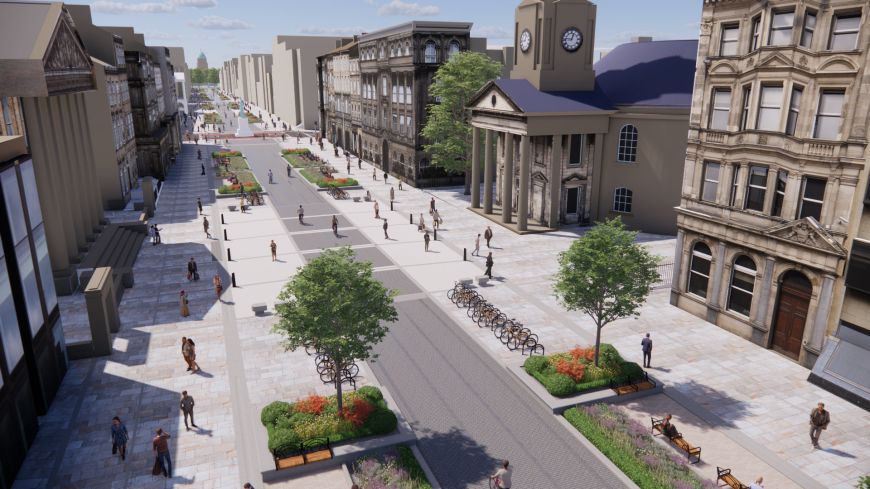
Trees are coming to one of Edinburgh’s most iconic streets, after a final operational plan for Edinburgh’s George Street and First New Town (GNT) project was approved this past week. As well as adding (a few) street trees, Edinburgh City Council’s Transport and Environment Committee also voted to maintain limited access for taxis and 24-hour access for Blue Badge disabled drivers.
The long anticipated, £36 million George Street re-design will create a two-way cycle carriageway down the middle of the street, currently used for car parking. Buses will be rerouted to avoid George street and cars will be treated as “guests”, with limited traffic access between 10am and 7pm (noon and 7pm on Sundays).
The cycleway will have rain gardens, granite planters and benches alongside it providing landscaped rest areas and city blocks will also have clutter-free, centre squares. A broad pedestrian pavement (approx four metres) on either side of the new-look, car-lite George Street will enable a more relaxed pedestrian experience and will allow for patio seating alongside cafes and restaurants.
Trees take route
A key change - after public feedback - to the original plan that was approved in November of last year is the introduction of trees to George Street. These will be planted within the limitations imposed by the historical character of the UNESCO World Heritage site.
The project report to council says: “George Street represents one of finest examples of ”Rus in Urbe” in Europe – the countryside in the city - whereby streets and squares are predominately hard in character with important vistas to planned parks and gardens….any positioning of trees must compliment the area’s original design principles (including James Craigs masterplan and not “overly soften” George Street) while maintaining views of the street’s unique architecture, monuments and axial alignment with Charlotte and St Andrew Squares.”
The report recognises at some length the benefits that street trees bring: mitigating the urban heat island effect, providing people with shade from the sun and absorbing water from extreme rainfall, as well as aligning with the city’s Net Zero 2030 goal and One Million Tree City pledge.
But George Street is not going to become a tree-lined boulevard, at least any time soon, in order to “minimise any risk to what is described as the “Outstanding Universal Value” of James Craig’s 1768 original New Town plan.
At this stage, two sets of 8 “gateway” trees (species not yet specified) would be planted at either end of George Street at St Andrew Square and at Charlotte Square. Trees would be 3.5 to 4 metres at planting and then root trained and maintained so that they don’t exceed 6 to 8 metres when mature.
A ground-penetrating radar survey showing what is under George Street in terms of basements and major utilities is due to be presented at the end of Summer 2023, which will also influence tree situating.
Limited vehicle access
Servicing and licensed taxi access on George Street will only be permitted during evening and morning hours, with automated bollards enforcing the pedestrian cycling zone restrictions.
But Blue Badge holders will still be able to park in disabled bays on George Street and the surrounding streets throughout the day.
The plan also maintains bus services in the wider First New Town (Hanover, Frederick and North/South St David Street).
Councillor Scott Arthur, Transport and Environment Convener, said:
“In updating designs and operational plans for the GNT project, the project team has worked closely with the community, key stakeholders and elected members to develop proposals which will both enhance the space for all those travelling through and spending time in the area but also retain the First New Town’s unique historic value.”
He added: “I know the potential inclusion of trees on George Street will be welcomed by many, now their inclusion has been approved more work will be done to ensure the position and type of trees is sympathetic to the street’s iconic character."
"We have also listened carefully to the Edinburgh Access Panel and have agreed blue badge holders should have full access to up to 27 Blue Badge spaces in the George Street and First New Town area."
"This latest update marks an exciting milestone in the GNT project and it will allow us to move forward with the final stages of development before construction begins.”
The George Street and First New Town project is being supported by funding from the Scottish Government through Sustrans Scotland’s Places for Everyone programme and delivered by City of Edinburgh Council.
SUSTRANS is covering 70% of the £30-32m construction budgeted costs for the project, with the Council required to cover potentially around £10 million.
The report was approved with a series of addendums and amendments from groups. These include agreements to consider the project’s impact on the wider Active Travel Investment Programme, to continue dialogue on licensed taxi access for people with disabilities and to explore how the plan can deliver priority for pedestrians, wheelers and cyclists while also ensuring accessibility for disabled people.
The GNT is part of a wider plan to transform Edinburgh City Centre into a more pedestrian and cycle friendly environment with improved active travel links to the Meadows to George Street project and the City Centre West to East Link out to Roseburn.
The next stage for the George Street project will be to progress the promotion of all the necessary statutory processes, which provide the powers to enable the construction of the project, scheduled for 2025.
Further engagement and analysis will be carried out on planned layouts for Hanover, Frederick and Castle Street during the next design stage in the process, RIBA Stage 4.
Awards
Earlier this year the George Street and First New Town project was shortlisted in the Pineapple Awards, which celebrate excellence in place-based design and development.
The project is also in the running as a finalist for the Scottish Design Awards in the Master Planning category.

